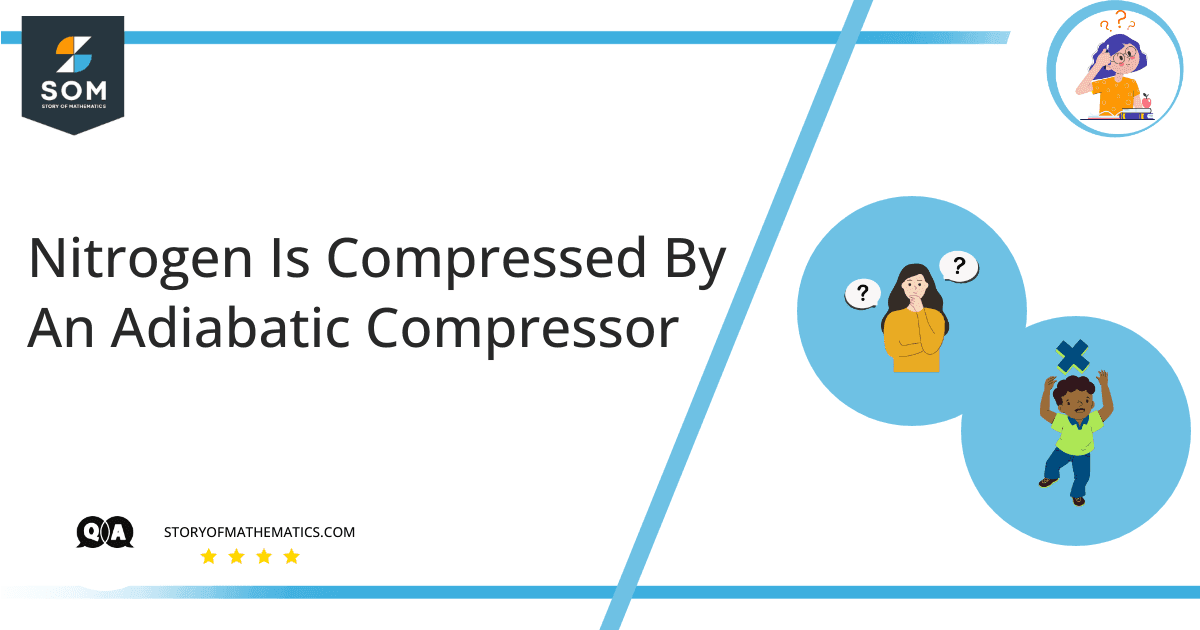
The aim of this problem is to find the entropy generation value of an adiabatic process in which nitrogen is compressed at a given temperature and pressure. The concept required to solve this problem is related to thermodynamics, which includes the entropy generation formula.
In general terms, entropy is described as a standard of randomness or disruption of a system. In the thermodynamics point of view, entropy is used to explain the behavior of a system in spans of thermodynamic characteristics such as pressure, temperature, and heat capacity.
If a process undergoes an entropy change $(\bigtriangleup S)$, it is described as the quantity of heat $(q)$ radiated or soaked isothermally and reversibly separated by the absolute temperature $(T)$. Its formula is given as:
\[\bigtriangleup S=\dfrac{q_{rev,iso}}{T}\]
The total entropy change can be found using:
\[\bigtriangleup S_{total}=\bigtriangleup S_{surroundings} + \bigtriangleup S_{system}\]
If the system radiates heat $(q)$ at a temperature $(T_1)$, which is acquired by surroundings at a temperature $(T_2)$, $ \bigtriangleup S_{total}$ becomes:
\[\bigtriangleup S_{total}=-\dfrac{q}{T_1} + \dfrac{q}{T_2} \]
One more important concept regarding this problem is entropy change for isothermal expansion of gas:
\[\bigtriangleup S_{total}=nR\ln (\dfrac{V_2}{V_1}) \]
Expert Answer
Given information:
Initial pressure, $P_1=100kPa$,
Initial temperature, $T_1=25^{\circ}$,
Final pressure, $P_2=600kPa$,
Final temperature, $T_1=290^{\circ}$.
The properties of nitrogen at the given temperature are:
Specific heat capacity, $c_p=1047\space J/kgK$ and,
Universal gas constant, $R=296.8$.
Now apply the total entropy equation on the compressor:
\[S_{in} – S_{out} + S_{gen}=\bigtriangleup S_{system} \]
\[S_{1-2} + S_{gen} = 0\]
\[q_m\cdot (s_{1} – s_2)+S_{gen} = 0 \]
\[S_{gen} = q_m\cdot (s_2 – s_1)\]
Since the amount of heat exchange between the system and the surroundings is negligible, the induced entropy rate is just the difference between the entropy at discharge and the inlet.
The formula to calculate the entropy change is derived from the expression $s = s(T,p)$:
\[\dfrac{S_{gen}}{q_m} = s_{gen} = s_2 – s_1 \]
Using the isothermal expansion equations to simplify:
\[=c_p\ln (\dfrac{T_2}{T_1}) – R\ln (\dfrac{P_2}{P_1})\]
\[=1047\ln (\dfrac{290+273}{25+273}) – 296.8\ln (\dfrac{600\cdot 10^3}{100\cdot 10^3}) \]
\[s_{gen}= 134 J/kgK \]
Numerical Result
The entropy generation for this process is $s_{gen}= 134 J/kgK$.
Example
Find the minimum work input when nitrogen is condensed in an adiabatic compressor.
The thermodynamic properties of nitrogen at an expected intermediate temperature of $400 K$ are $c_p = 1.044 kJ/kg·K$ and $k = 1.397$.
Since there is only one channel in and one exit, thus $s_1 = s_2 = s$. Let’s take the compressor as the system, then the energy balance for this system can be yielded as:
\[E_{in} – E_{out} = \bigtriangleup E_{system} = 0\]
Rearranging,
\[E_{in} = E_{out} \]
\[mh_1 + W_{in} = mh_2 \]
\[ W_{in} = m(h_2 – h_1) \]
For minimum work, the process should be reversible and adiabatic as given in the statement, so the exit temperature will be:
\[ T_2 = T_1 \{\dfrac{P_2}{P_1}\}^{(k-1)/k} \]
\[ T_2 = 303\{\dfrac{600 K}{120 K}\}^{(0.397)/1.397} = 479 K \]
Substituting into the energy equation gives us:
\[ W_{in}= m(h_2 – h_1) \]
\[ W_{in} = c_p (T_2 – T_1) \]
\[ W_{in} = 1.044(479- 303) \]
\[ W_{in}= 184 kJ/kg \]
